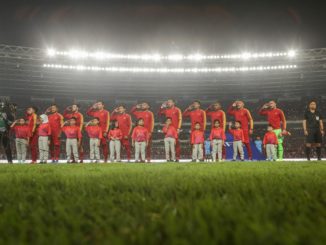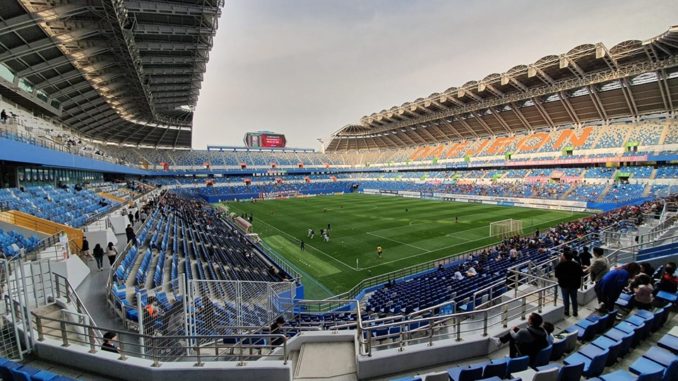
The 2002 FIFA World Cup saw co-hosts South Korea emerge onto the global stage with an improbable run to the semi-finals. However, nearly 20 years on from that historic event some of its lasting legacies continue to hinder the growth of club football. Ryan Walters dives into one unwanted legacy and what clubs can do to escape it.
The penultimate weekend of the 2019 K League 1 season saw one the best crowds in recent memory as Ulsan Hyundai hosted Jeonbuk Hyundai Motors with the title on the line.
The high stakes were always going to create a buzz around the match, but the true intensity came down to the packed North and South stands, with supporters in full voice, flags throughout the stadium, drums reverberating in every corner of the ground, and banners on full display.
There was a spirit unlike anything Ulsan had seen this season, and one that was only possible with the Horang-i hosting the match outside of their usual home confines, Munsu Football Stadium, located on the far edges of town and one of many behemoths leftover from the 2002 World Cup that seats over 44,000, and that kills any atmosphere fans may try to create.
Instead, the match was held in the more appropriately sized, and centrally-located, Ulsan Stadium with 19,011 spectators filling up its 19,471 seats.
Helped along by some end-to-end play and two spectacular goals, the energy in the stadium throughout the match was noticeably different than anything in recent memory at Munsu. Despite the 1-1 scoreline that prevented Ulsan from lifting the trophy, new and casual fans of the league will have left with a positive impression of K League due to the vastly improved environment, and will be far more likely to come back after being part of such a spirited crowd.
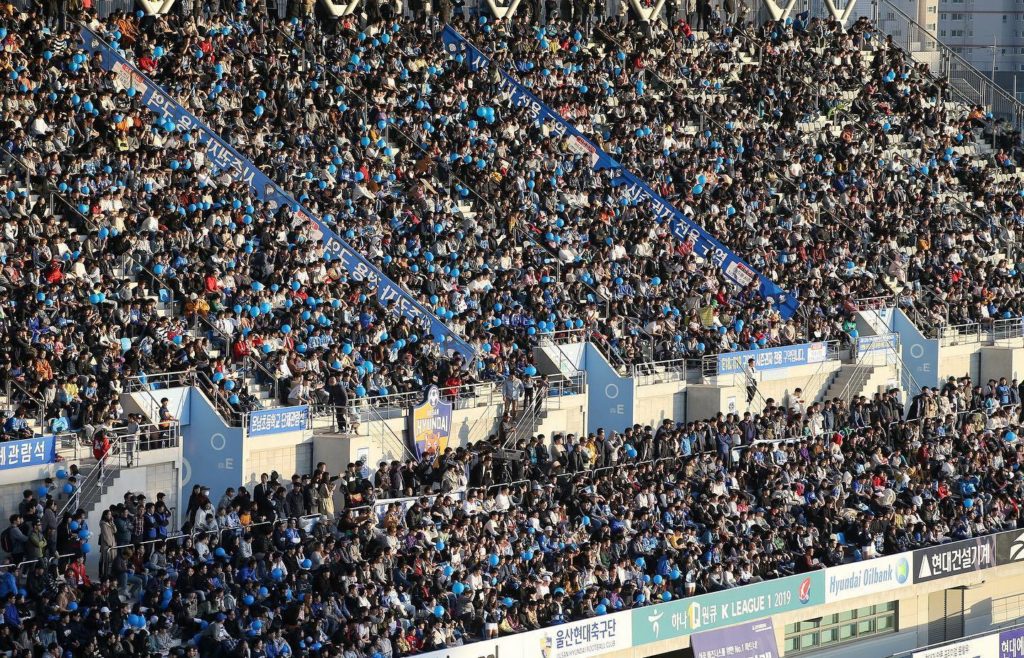
(Photo: Ulsan Hyundai)
Such an occasion usually only happens when the national team plays – a tradition in place for decades, but one that was solidified at the turn of the century.
The 2002 World Cup introduced Korean football to the world in many ways, and immortalised players who are still giants in this country.
Ahn Jung-hwan’s golden goal against Italy famously sent the South Koreans to the quarter finals and also got him dismissed from Italian club AC Perugia all in one go – a moment that is still frequently talked about to this day.
The Taeguk Warriors then went on to beat Spain on penalties before eventually bowing out to Germany in the semi-final.
Titans of the sport like Park Ji-sung used the tournament to springboard their career on to previously unforeseen heights, joining Manchester United and winning nearly every trophy available to him.
Others like Choi Yong-soo and Hwang Sun-hong went on to manage their clubs to the K League title and establish themselves to an entirely new generation of fans as football legends.
Off-the-field, Kim Byung-ji and Hyun Young-min can be seen on camera weekly having taken up commentary positions with major Korean TV networks. Regardless of where you look, it’s nearly impossible to avoid seeing some remnant of the 2002 World Cup here in Korea.
However, the tournament had another long lasting legacy that continues to plague the domestic league, and that is its stadiums.
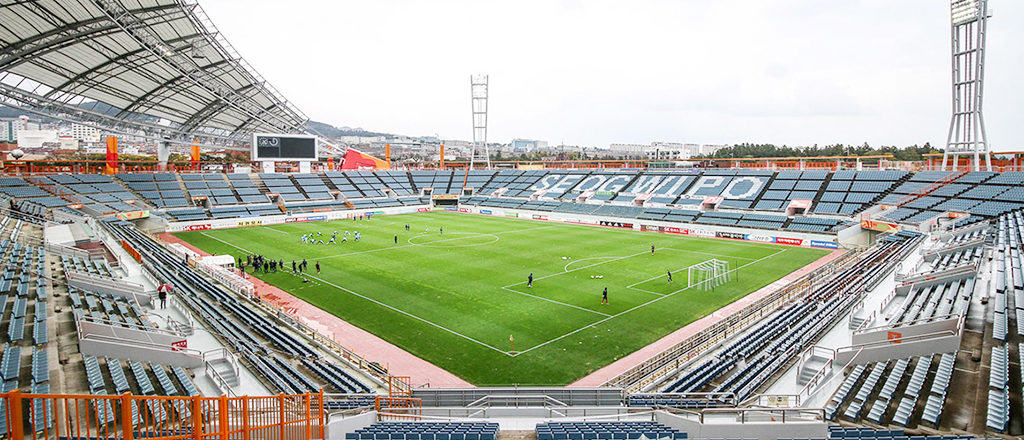
(Photo: Jeju United)
Ten brand-new stadiums were built throughout South Korea for the 2002 tournament, all of which had a capacity over 40,000, and needed use once the international spectacle had finished.
With millions spent on construction, the venues needed tenants to pay back the city governments that footed the bill. This forced a dramatic restructuring of the K League and the cancellation of the controversial Decentralisation Policy that forced Ilhwa Chunma, LG Cheetahs, and Yukong Elephants out of Seoul in 1996 in an effort to attract fans outside of the capital area to the sport.
They eventually found homes in Cheonan, and Seoul satellite cities Anyang and Bucheon respectively. Unfortunately for their fans, vacant World Cup stadiums complicated matters considerably just a few years later.
With a 25 million dollar bill hanging over Seoul Metropolitan Government, the city began the search for a new team to take over the 66,000+ seater stadium on the west side of the city.
With the Korean Football Association stepping in to help foot some of the costs, Anyang LG Cheetahs eventually emerged as the team that would move back to the capital to became FC Seoul, a move that Anyang fans still resent and one that has pegged them as villains for 15 years.
Regardless of any discontent, the club had a new home and a lot of seats to fill.
Of course with ten different stadiums requiring new tenants, FC Seoul weren’t alone in relocating to take up residence in the colossal venues throughout the country.
The aforementioned Yukong Elephants eventually left Bucheon to fill Jeju World Cup Stadium in 2006, another controversial move the Bucheon fanbase has not forgotten, and one that spurred them on to create a citizen-owned club years later.
Despite spurned fanbases, it only took a few short years for all of the World Cup stadiums to be filled by teams across the country.
Bound by a duty to help city governments and the burgeoning K League, teams were handcuffed by grossly oversized stadiums that prevented a supporters’ culture from ever truly taking root.
To put things in perspective, the ten clubs that called the World Cup stadiums home were dealing with venues larger than Chelsea’s Stamford Bridge, and Tottenham’s White Hart Lane. FC Seoul and Daegu FC were playing in stadiums larger than Arsenal’s Emirates Stadium, and the brand new Tottenham Hotspur Stadium.
Citizen-owned Daegu FC was tasked with filling a stadium roughly the same size as Atletico Madrid’s Wanda Metropolitano and located miles away from downtown. Predictably, they never came close. Even attracting a respectable 20,000 fans would barely fill a third of the stands and would create a truly lacklustre tone to the proceedings.
Despite the albatross that is a World Cup Stadium and years of low attendances, K League enjoyed a 47% spike in attendance across the board in K1 and 74% in K2 this year.
Last season (2018) saw particularly low numbers because the league stopped counting free tickets in an effort to better reflect paid attendances for each club, and this season saw a significant bump. But even that hasn’t been quite enough to fill the void.
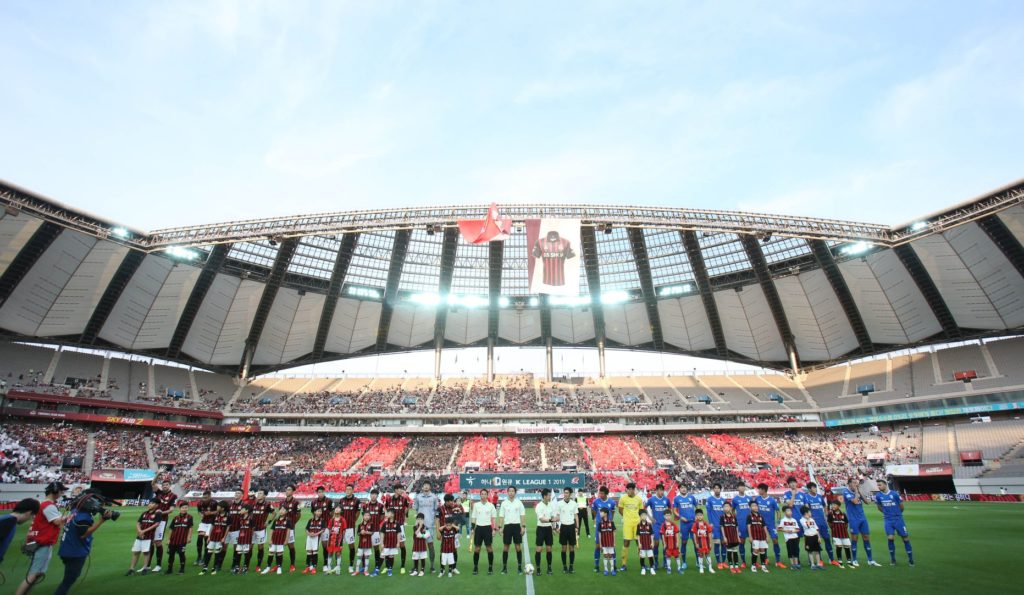
(Photo: FC Seoul)
Once again, FC Seoul serve as the prime example. The capital club has enjoyed a 47% increase in attendance this season for an average of just over 17,000. That is equal to or higher than 12 of the 18 teams in the Eredivisie, half of the teams in Ligue 1, eight La Liga teams, and seven clubs in Italy’s Serie A.
And yet an average attendance respectable enough for some of Europe’s top leagues still only manages to put FC Seoul at quarter capacity in the 66,704 Seoul World Cup Stadium. Even their high water mark of 32,057 for this year’s Super Match against arch-rivals Suwon Samsung Bluewings left half the seats vacant.
With such an unconquerable task put before them, a number of K League clubs have thrown in the towel on World Cup Stadiums and have already seen significant benefits.
As any decent restaurant owner will tell you, demand is essential for a thriving business. K League has never really been in a position to be in demand because the majority of teams play in stadiums three to four times too large and tickets will always be available.
In a way, this is nice for fans to know they can simply show up on game day and get in. Yet, it prevents any buzz around the club throughout the city as friends discuss getting tickets throughout the week and the compelling aspects of the game.
Creating that kind of demand forces people to think about the match for longer than the two hours they’ll be in the stadium and positions clubs to promote an in-demand product as opposed to essentially begging people to turn up in hopes of filling a stadium to half capacity.
This type of demand is something Daegu FC understands all too well and was the main reason they abandoned the mammoth 68,014 seater Daegu World Cup Stadium in favor of the 12,415 Daegu Bank Park.
Since moving away from Korea’s second largest stadium, Daegu have enjoyed nine sell outs this season, including the final match that sold out within hours of tickets going on sale, as they prepared to host FC Seoul in a battle for the final AFC Champions League (ACL) spot.

(Photo: Daegu FC)
The move has also seen a 200% increase in attendance this year for just over 10,000 a game. A number that nearly fills their new stadium as opposed to leaving nearly 60,000 seats empty and asking fans to somehow fill the gargantuan void.
Winning the 2018 FA Cup, making their ACL debut this season, fighting for Champions League again this year, and starting Korean national team goalkeeper Cho Hyun-woo in goal has given Daegu FC a lot to work with.
The on-field success is unquestionably one of the main reasons Daegu have enjoyed a spike in attendance, but it’s not always a requirement. Even Incheon United, who narrowly avoided relegation to K2 yet again this year, have seen a 92% increase in attendance in the gorgeous 20,891 seater Incheon Football Stadium, for an average of 8,500.
They won’t set any records with that attendance, but playing in a football specific stadium as opposed to the multi-purpose 52,000+ Incheon Munhak Stadium where they played from 2003-2011 has at least allowed the club to engage with their fans. Something a growing number of Korean clubs are setting their sites on by moving to more intimate venues.
Much like Daegu and Incheon, fellow citizen-owned club Gwangju FC will similarly make the move away from Gwangju World Cup Stadium and its 40,000+ seats in their return to K1 next season.
Construction has already begun on the auxiliary pitch next to the stadium and will max out somewhere between 7,000 and 10,000. Reducing their capacity by 75% to more accurately accommodate the 3,100 spectators they averaged this season is a shrewd move for a club looking to thrive in their return to K1.
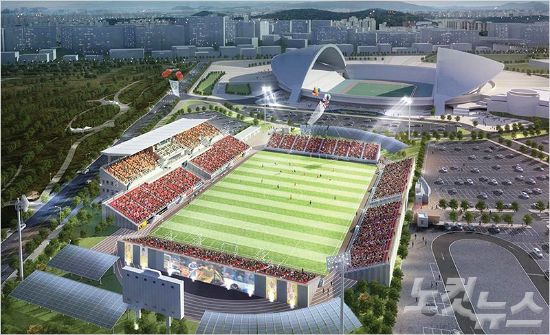
(Photo: Gwangju FC)
Assuming a few thousand more turn up to see top flight football next season, Gwangju will regularly be at half capacity in a ground where their supporters chants will echo off each other as opposed to tens of thousands of empty seats.
The move marks the fourth K League club to abandon their World Cup stadium after Incheon, Busan, and Daegu all led the way, and it’s a trend that isn’t likely to stop there either.
With Daejeon Citizen recently taken over by Hana Financial Group, and playing in the 40,535 capacity Daejeon World Cup Stadium (main photo), it seems only a matter of time before they follow suit. The benefits of such a move are easily quantifiable at the ticket box, and as Daegu have shown that’s no small perk.
From a fan perspective, there are arguably more important and entirely intangible effects on the match day experience. Instead of walking into a majority empty stadium and immediately being underwhelmed by the seemingly tiny supporters section fruitlessly attempting to set the tone, fans can emerge from the concourse to a raucous crowd with drums shaking the very ground they stand on and players close enough to nearly hear them talking to each other.
Chants will actually be heard and much more easily picked up by casual fans as the sound stays trapped in the intimate space instead of fading out into the ether.
That feeling of emerging from the darkness of the concourse to see the colours of the pitch and hear the sounds of the crowd for the first time is an addictive drug that teams have been selling for year on year, and one that it’s high time K League got in on.
Teams unburdened by the World Cup legacy have realised this at long last and have made moves to improve their match day experience.
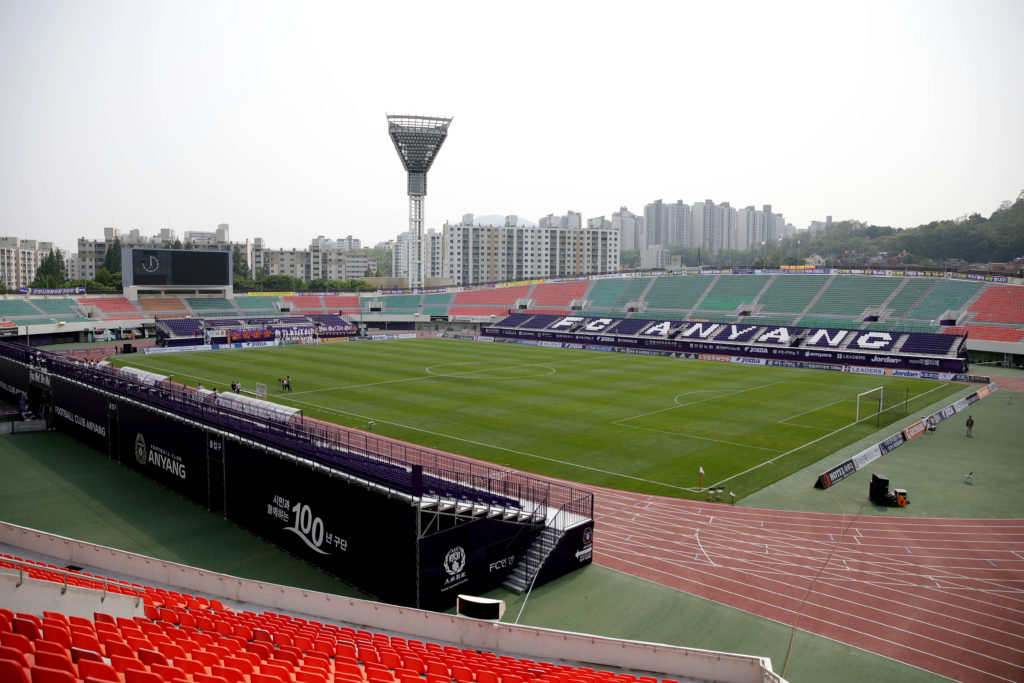
K2’s FC Anyang put in three temporary stands around their ground this year to bring fans closer to the pitch and enjoyed one of their best seasons in history on and off the pitch largely because of it. They finished third in the league and were narrowly eliminated from the Promotion Playoffs and saw a 142% increase in attendance for an average of 3,600.
Dispersed throughout the 17,000 seater Anyang Stadium, that feels like next to nothing. But packed into the newly installed stands next to the pitch, there’s an atmosphere to be had.
If club football is ever going to live up to its tremendous potential in South Korea, more teams need to take the bold step of pulling the plug on the World Cup stadiums that have overshadowed them for far too long.
The legacy of the 2002 World Cup and what that spirited group of men did for this country will forever live on in the hearts of football fans. We no longer need the venues as reminders. Rather than looking to the past for inspiration, it’s high time K League creates some of its own.


